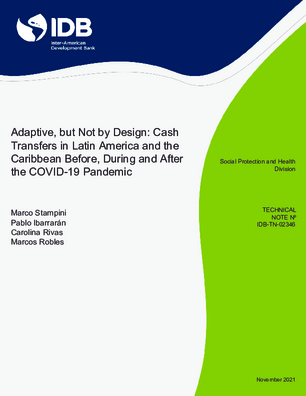Adaptive, but not by design: cash transfers in Latin America and the Caribbean before, during and after the COVID-19 Pandemic
Date
Nov 2021
The socioeconomic crisis associated with the pandemic put cash transfer programs back at the top of the policy agenda. It showed that the Latin American and Caribbean regions income support systems were both fundamental and insufficient. In this paper, we present novel estimates of the coverage and beneficiary distribution of all non-contributory cash transfers both before and during the COVID-19 crisis. The former is useful to show the degree of preparedness of the region. The latter analyzes the magnitude of the policy response. While the literature presents estimates of coverage and leakage of conditional cash transfers and non-contributory pensions, our results are novel because they are the first to analyze coverage and leakage implemented in response to the COVID-19 crisis. In addition, we are the first to expand the focus to all non-contributory cash transfer programs, including those that are quasi-universal and/or unconditional. This is the most appropriate focus when the goal is to assess the ability to provide protection to larger population groups (including the vulnerable) and against transitory poverty caused by systemic shocks (such as pandemic or extreme weather events, which may become more and more frequent due to climate change). Using data from the Inter-American Development Bank “Harmonized Household Surveys from Latin America and the Caribbean”, which now provide a more comprehensive coverage of Caribbean countries, we show that before the pandemic non-contributory cash transfers covered 26% of the population of 17 countries with available data. Average coverage of the extreme poor, moderate poor and vulnerable population was 56%, 43% and 28% respectively. During the crisis, LAC governments implemented 111 new cash transfer interventions, increasing coverage to 34% of the population in 12 countries with available data. Average coverage increased among the moderate poor (50%) and vulnerable population (37%), while it remained unvaried amongst the extreme poor. Moving forward, the countries of the region are called to reform their social protection systems to make them more flexible, efficient, and sustainable, and including strategies that provide protection against shocks. In this way, resilient and responsive social protection systems can contribute to the fight against climate change and support a just transition towards net-zero emission societies. These efforts must also include measures to close the historical coverage gap amongst the poorest.




